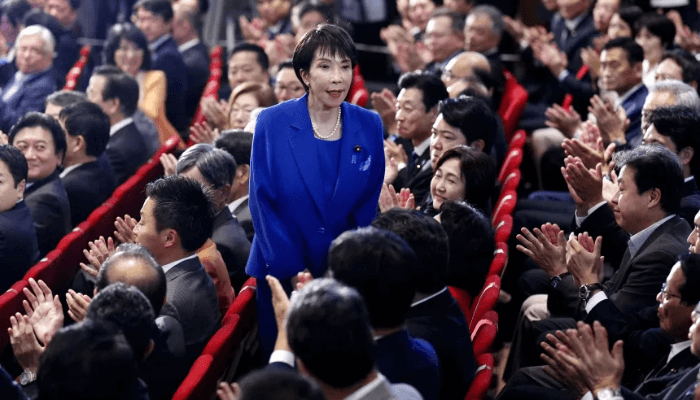Sanae Takaichi, center, stands as she was chosen to be the new leader of Japan’s ruling Liberal Democratic Party in Tokyo on October 4, 2025. Kyodo News/AP
Japan’s ruling Liberal Democratic Party (LDP) on Saturday elected Sanae Takaichi, former economic security minister as its new leader, putting her on course to become the country’s first female prime minister.
The 64-year-old conservative, a close ally of the late Shinzo Abe, defeated agriculture minister Shinjiro Koizumi in a runoff vote after neither candidate secured a majority in the first round. The victory cements her position as the frontrunner to succeed outgoing prime minister Shigeru Ishiba, who resigned after a year marked by political turmoil and electoral losses.
Read also:Meet Japan’s next prime minister candidates
A parliamentary vote to formally confirm Takaichi as prime minister is expected on October 15. While the LDP no longer holds an outright majority, it remains the largest party in the lower house — which determines the head of government — making her confirmation almost certain.
A historic first for Japan
In a country that consistently ranks low in global gender equality indices, Takaichi’s rise is historic. No woman has ever led Japan in its post-war history. Yet her victory also underscores the complex realities of Japanese politics: Takaichi is among the most conservative figures in the LDP, a party long dominated by men and traditionalist values.
Read also: Japan scraps exchange programme after ‘Kisarazu as Nigeria’s hometown’ distortion
A protégé of Abe, she has pledged to revive his economic programme known as Abenomics — a mix of heavy government spending, loose monetary policy and structural reform aimed at reviving growth.
“Takaichi’s leadership will likely mean continuity with Abe’s policies, particularly in the economy and national security,” said Stephen Nagy, a visiting fellow at the Japan Institute for International Affairs told Al Jazeera “She represents the conservative core of the LDP.”
Conservative credentials and controversies
Takaichi has long been known for her strong views on social and national identity issues. She opposes legislation allowing married couples to keep separate surnames and is against legalising same-sex marriage, arguing such changes would undermine Japanese traditions.
She is also a regular visitor to the Yasukuni Shrine, which honours Japan’s war dead, including several convicted war criminals, a practice that often draws criticism from China and South Korea.
Read also: Ishiba resigns as Japan PM after election loss, pledges handover to younger generation
On foreign policy, she has taken a hawkish stance, calling for a stronger military and a revision of Japan’s pacifist constitution. She is expected to face early pressure on defence spending when she meets Donald Trump,United States president at a potential summit later this month.
A party in need of revival
Takaichi inherits a party that has dominated Japanese politics for nearly seven decades but is now struggling to maintain public trust. The LDP suffered back-to-back defeats in national elections, losing its majority in both chambers of parliament for the first time in decades.
Saturday’s vote involved 295 LDP lawmakers and about one million dues-paying party members — a small fraction of Japan’s 125 million people. Many analysts see her victory as a bid by the LDP establishment to consolidate its base rather than signal generational or ideological change.
Koizumi, 44, who came second in the runoff, had campaigned on party reform and generational renewal, describing the LDP’s current state as “a crisis”. His defeat means Japan will continue to be led by a traditional conservative rather than a centrist moderniser.
Challenges ahead
If confirmed, Takaichi will face an uphill battle: an ageing population, rising living costs, and a slowing economy weighed down by debt. Abroad, Japan confronts an increasingly volatile region marked by China’s assertiveness, North Korea’s missile programme and the uncertainties of Trump’s trade policies.
She will also have to unite a divided party and rebuild its standing before the next general election.
“The LDP must regain trust, and an overhaul is needed for us to start afresh,” Koizumi said during the campaign.
For Takaichi, Japan’s first female prime minister-in-waiting, the task ahead is daunting — not just to lead, but to prove that breaking history can also mean breaking stagnation.









